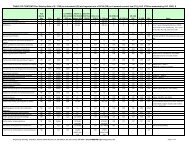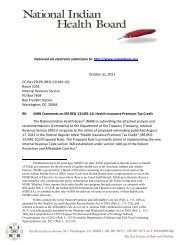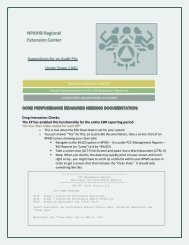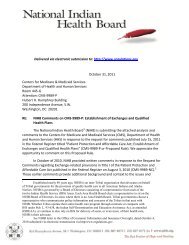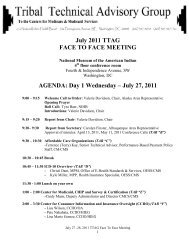mmpc - National Indian Health Board
mmpc - National Indian Health Board
mmpc - National Indian Health Board
Create successful ePaper yourself
Turn your PDF publications into a flip-book with our unique Google optimized e-Paper software.
Methods<br />
group for the statistical models used in this report to adjust for undetermined differences in<br />
Medicaid programs across the IHS Areas at the county level, and measure adjusted Racial Disparities<br />
in morbidity and Medicaid payments.<br />
Analysis Plan<br />
The questions to be answered by the analyses are, 1) What variables determine the mean total<br />
payment per recipient for IHS AIAN, Other AIAN and Whites? and if those determinants are adjusted,<br />
2) What are the adjusted mean payments for IHS AIAN across the 12 IHS Areas? And 3)How can<br />
those mean payments be used to determine what Medicaid pays for IHS AIAN Active User health<br />
care costs? In this Methods section we restrict the study groups in a systematic way step by step<br />
making the analytical groups more homogeneous and more and more representative of the groups<br />
we mean to compare. We then build models that adjust for determinants that affect large numbers of<br />
recipients In Findings Section I we present the findings from those models that test for the effects of<br />
potential determinants on the payment outcome. In Findings Section II we see how those effects<br />
affect the fraction of the mean total payment per IHS Active User that is paid by Medicaid for the 12<br />
IHS Areas.<br />
Outcome of Analysis: Mean Total Payment per Medicaid Recipient<br />
The analysis is governed by selection of the dependent – or outcome – variable used in the analyses<br />
to measure payments. Particular care has been taken to target the Mean Payment per Person<br />
measure that is most relevant to the goal that we were commissioned to investigate: identify the<br />
contributions of characteristics of the IHS AIAN, state Medicaid programs and the IHS system of<br />
healthcare to Medicaid program payments for medical, dental and behavioral health care of IHS<br />
AIAN. Specific objectives are to determine how those characteristics vary for IHS AIAN across the<br />
twelve IHS administrative areas, and how those characteristics differ for other AIAN and for whites<br />
who also live in the counties of the IHS Areas.<br />
Because of the varying role of private insurance in total payments for Medicaid claims in certain IHS<br />
Areas (in particular, Nashville Area) we include Third Party Payments in the outcome measure for<br />
the analyses and analyze the Total Payment to avoid bias in analyses across IHS Areas (Attachment<br />
Table C.1). Third Party Payments for Medicaid and CHIP program claims can be paid in part by third<br />
parties, rather than the Medicaid or CHIP programs themselves. Third Party Payments for Medicaid<br />
program claims are mainly private insurance payments for Medicaid enrollees under age 65, and<br />
Medicare payments for those over age 65.<br />
Because of differences in systems of claims and payments for acute medical care in Fee-for-Service<br />
(FFS) and capitated Comprehensive Managed Care Plans (CMCP, medical managed care plans), we<br />
analyze results separately for these two groups. Within each group, however, we sum paid claims<br />
and monthly premium (Capitated) paid claims for Prepaid <strong>Health</strong> Plans (PHP, behavioral health and<br />
dental managed care plans) for both FFS and CMCP recipients, and Primary Care Case Management<br />
6





